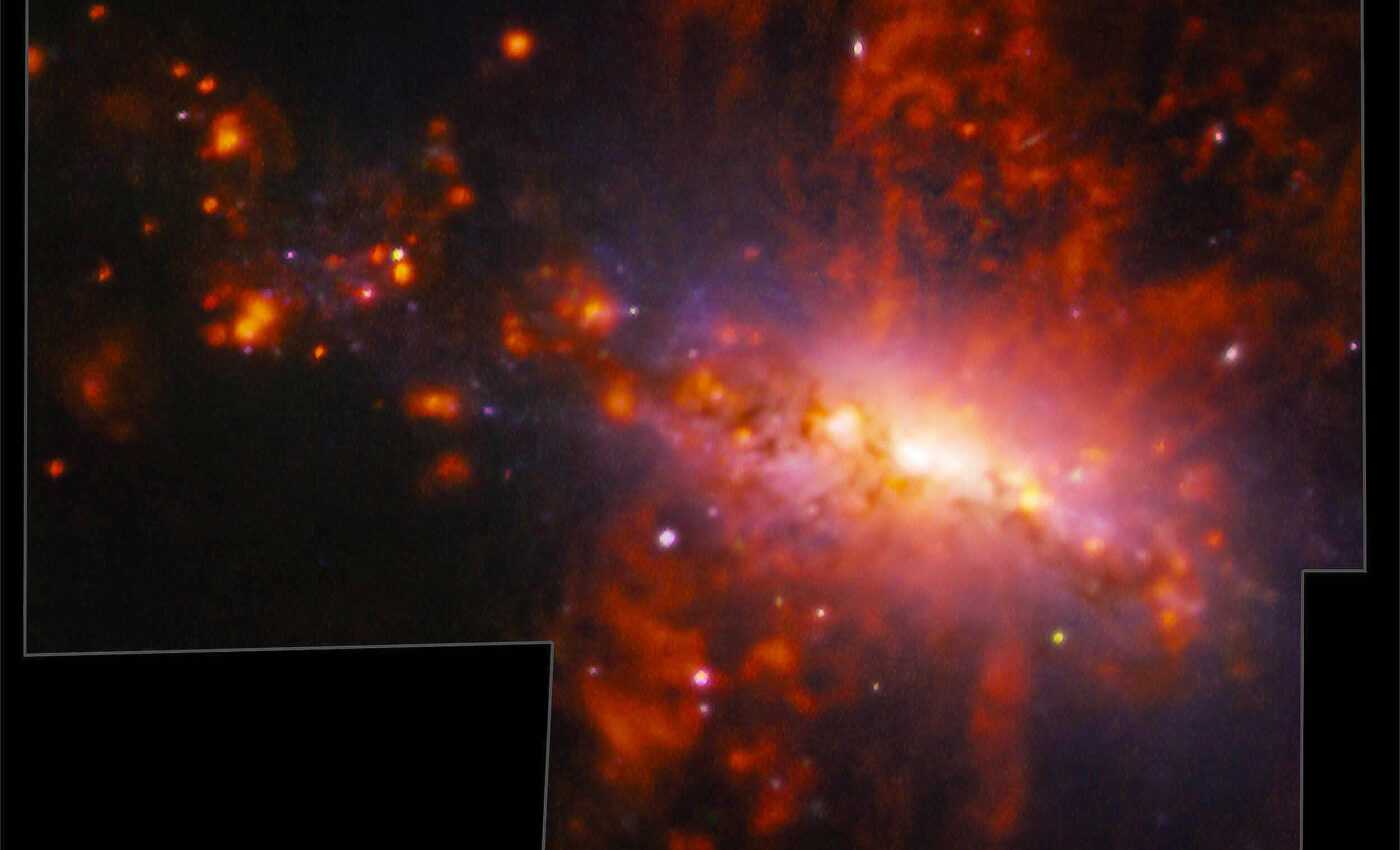
Massive galactic explosion provides clues about galaxy evolution
Astronomers have recently created a high-resolution map showcasing a colossal outflow of gas within the nearby galaxy NGC 4383. This galactic explosion is shedding light on the intricate processes that contribute to the chemical enrichment of intergalactic space and provides clues about the mechanisms that regulate galaxy evolution.
Intergalactic enrichment
Galaxies are vast, dynamic environments where stars act as cosmic factories, transforming simple elements into heavier ones throughout their lives. During their final, explosive stages – called supernovae – these stars blast out immense quantities of gas laced with the complex elements they’ve created.
This stellar debris mixes with the existing gas and dust within the galaxy, a region known as the interstellar medium. The infusion of these heavier elements increases the overall richness of the interstellar medium, providing new building blocks for subsequent generations of stars and planets.
Through this process of cosmic recycling – stellar birth, element production, supernova dispersal, and the formation of new celestial bodies – galaxies steadily evolve and change their chemical makeup.
Galactic explosion in NGC 4383
The detailed observations of NGC 4383 have revealed a truly exceptional gas outflow, emphasizing the scale and power of such galactic explosions within galaxies. Key findings of this study include:
Scale and velocity
The sheer size of the expelled gas is extraordinary. Traveling at light speed, it would take 20,000 years to cross the entire structure. To put the velocities into perspective, the ejected material speeds outward in excess of 200 kilometers per second – hundreds of times faster than a bullet train.
Chemical composition
Scientists analyzed the light from the outflow to determine its makeup. They discovered a diverse mixture of heavier elements, including essential building blocks of life like oxygen, nitrogen, and sulfur, along with numerous others. This indicates that the outflow is not just leftover debris, but a treasure trove of ingredients for future cosmic structures.
Mass
Astonishingly, the total mass contained within this outflow is equivalent to over 50 million times the mass of our Sun. This underscores the immense energy involved in such galactic events and the substantial amount of material they can displace.
Capturing NGC 4383’s outflow
This significant breakthrough highlights the power of advanced astronomical tools and surveys in pushing the boundaries of our knowledge. Here’s a breakdown of the key components:
MAUVE survey
This large-scale project meticulously maps galaxies using cutting-edge instruments. Its aim is to understand how galaxies evolve, including investigating the role of gas flows into and out of these cosmic structures.
MUSE integral field spectrograph
MUSE is a sophisticated instrument that collects light and splits it into its component colors (a spectrum). Crucially, it does this simultaneously for many points across an extended object like NGC 4383’s gas outflow. This allows scientists to map the velocity, temperature, and chemical composition of the outflow in unprecedented detail.
European southern observatory’s Very large telescope (VLT)
The VLT is a world-leading astronomical observatory located in Chile. It consists of multiple telescopes that operate together and are equipped with state-of-the-art instruments like MUSE, enabling researchers to make groundbreaking discoveries.
The combination of the MAUVE survey’s focus, MUSE’s capabilities, and the power of the VLT telescopes provided the ideal conditions for scientists to capture such stunning details of NGC 4383’s remarkable outflow.
Implications of NGC 4383’s explosion for galactic evolution
“Very little is known about the physics of outflows and their properties because outflows are very hard to detect,” noted lead author Dr Adam Watts, from The University of Western Australia node at the International Centre for Radio Astronomy Research (ICRAR). The case of NGC 4383 addresses this challenge, offering fresh insights into galactic outflows. These processes play a crucial role in several facets of galaxy evolution:
Regulation of star formation
Stars are born within dense clouds of gas and dust within galaxies. This raw material needs to collapse under its own gravity to trigger star formation.
Powerful outflows, driven by things like supernova explosions and intense radiation from massive stars, act like a powerful cosmic broom. They can disrupt and disperse the gas clouds, essentially removing the fuel needed for future star formation.
When star-forming material is swept away, the galaxy has a harder time making new stars. This can significantly slow down the overall rate of star formation and affect how long a galaxy remains actively star-forming.
Outflows are a crucial regulating mechanism in galaxies. Without them, galaxies might burn through their star-forming fuel too quickly. Outflows help galaxies maintain a more sustainable level of star formation over long periods of time.
NGC 4383’s long-term legacy
The gas ejected by galactic outflows doesn’t just vanish into the void. Instead, it becomes a part of the vast intergalactic medium – the space between galaxies.
Over time, the dispersed material mixes with the existing gas in the intergalactic medium. This gradually alters its overall chemical makeup, increasing the abundance of heavier elements produced in stars.
These enriched pockets of intergalactic gas could then influence subsequent galaxy formation. When new galaxies form, they draw in this material, starting off with a more complex mix of elements than the earliest galaxies in the universe.
Galactic outflows leave a lasting chemical fingerprint on the cosmos. They play a subtle but essential role in the universe’s ongoing evolution.
“We hope that in the future, MAUVE observations reveal the importance of gas outflows in the local Universe with exquisite detail,” commented Professor Barbara Catinella, co-author and co-leader of the MAUVE survey. NGC 4383 provides a fascinating puzzle piece, helping astronomers understand the complex interplay between stars, galaxies, and the grand tapestry of the cosmos.
The study is published in Monthly Notices of the Royal Astronomical Society.
Image Credit: ESO/A. Watts et al
—–
Like what you read? Subscribe to our newsletter for engaging articles, exclusive content, and the latest updates.
Check us out on EarthSnap, a free app brought to you by Eric Ralls and Earth.com.
—–













